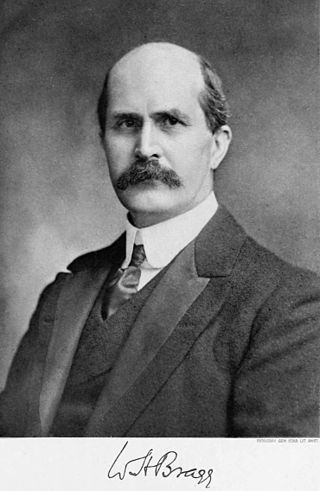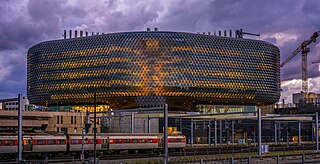
The University of Adelaide is a public research university located in Adelaide, South Australia. Established in 1874, it is the third-oldest university in Australia. The university's main campus is located on North Terrace in the Adelaide city centre, adjacent to the Art Gallery of South Australia, the South Australian Museum, and the State Library of South Australia.

Sir William Lawrence Bragg, was an Australian-born British physicist and X-ray crystallographer, discoverer (1912) of Bragg's law of X-ray diffraction, which is basic for the determination of crystal structure. He was joint recipient of the Nobel Prize in Physics in 1915, "For their services in the analysis of crystal structure by means of X-rays"; an important step in the development of X-ray crystallography.

The Royal Institution of Great Britain is an organisation for scientific education and research, based in the City of Westminster. It was founded in 1799 by the leading British scientists of the age, including Henry Cavendish and its first president, George Finch. Its foundational principles were diffusing the knowledge of, and facilitating the general introduction of useful mechanical inventions and improvements, as well as enhancing the application of science to the common purposes of life.

Sir William Henry Bragg was an English physicist, chemist, mathematician, and active sportsman who uniquely shared a Nobel Prize with his son Lawrence Bragg – the 1915 Nobel Prize in Physics: "for their services in the analysis of crystal structure by means of X-rays". The mineral Braggite is named after him and his son. He was knighted in 1920.

Port Pirie is a small city on the east coast of the Spencer Gulf in South Australia, 223 km (139 mi) north of the state capital, Adelaide. Port Pirie is the largest city and the main retail centre of the Mid North region of South Australia. The city has an expansive history which dates back to 1845. Port Pirie was the first proclaimed regional city in South Australia, and is currently the second most important and second busiest port in SA.

Susan Adele Greenfield, Baroness Greenfield, is an English scientist, writer, broadcaster and member of the House of Lords. Her research has focused on the treatment of Parkinson's disease and Alzheimer's disease. She is also interested in the neuroscience of consciousness and the impact of technology on the brain.

The Royal Institution Christmas Lectures are a series of lectures on a single topic each, which have been held at the Royal Institution in London each year since 1825. The lectures present scientific subjects to a general audience, including young people, in an informative and entertaining manner. Michael Faraday conceived and initiated the Christmas Lecture series in 1825, at a time when organised education for young people was scarce. Many of the Christmas Lectures were published.
Cosmos is a science magazine published in Adelaide, South Australia, by the Royal Institution of Australia that covers science globally. It appears four times a year in print as Cosmos Magazine, and the online edition is updated daily with news as well as long features and multi-media content, and includes the print magazine content. Cosmos Weekly is a subscription-based weekly online edition published on Fridays, and a podcast was launched in April 2022.

Edmund William Wright was a London-born architect in the colony of South Australia. He was mayor of Adelaide for 10 months in 1859. He designed many civic, commercial, ecclesiastical, and residential buildings in Adelaide city centre and its suburbs, in styles influenced by French and Italian Renaissance, as well as Neoclassical architecture. He collaborated with other notable architects E. J. Woods, Isidor Beaver, and Edward Hamilton in designing some of the most notable buildings.
The SCINEMA International Science Film Festival is an Australian film festival celebrating international science-related drama and documentary films. The festival was founded with the aim of forging links between the sciences and the arts. SCINEMA accepts entries from all over the world. It is a program of Australia's Science Channel, operated by the Royal Institution of Australia.
The Australian Science Media Centre (AusSMC) is an independent, not-for-profit service for the news media based in Adelaide, South Australia]]. Established in 2005, the centre gives journalists direct access to evidence-based science and expertise.

Pirie Street is a road on the east side of the Adelaide city centre, South Australia. It runs east–west, between East Terrace and King William Street. After crossing King William Street, it continues as Waymouth Street. It forms the southern boundary of Hindmarsh Square which is in the centre of the north-east quadrant of the city centre.
East Terrace is a road that marks the eastern edge of the Adelaide city centre in Adelaide, South Australia.
Henry Rymill and Frank Rymill were brothers prominent in business and public service in the 19th century South Australia. Henry "Harry" Rymill and Francis "Frank" Rymill were born in England, sons of Robert Rymill and Louisa Rymill of Shepperton, and migrated to South Australia, arriving at Port Adelaide in the Caucasian on 1 October 1855. Their company H & F Rymill was a prominent financial institution well into the 20th century. Their families included a number of prominent Adelaide citizens.

Tanya Mary Monro is an Australian physicist known for her work in photonics. She has been Australia's Chief Defence Scientist since 8 March 2019. Prior to that she was the Deputy Vice Chancellor, Research and Innovation (DVCR&I) at the University of South Australia. She was awarded the ARC Georgina Sweet Australian Laureate Fellowship in 2013. She was the inaugural director of the Institute for Photonics & Advanced Sensing (IPAS). Monro has remained an adjunct professor of physics at the University of Adelaide following her departure from the institution. In 2020 she was awarded the title of Emeritus Professor at the University of South Australia.
Javier Moll is a Spanish businessman and owner of the Barcelona-based media company Editorial Prensa Ibérica. In 2007 his company owned more than 20 newspapers in Spain and Portugal. He currently owns assets in South Australia, including The Adelaide Review, which he purchased in 2002, and has investments in South Australian wineries and real estate. As of 2015, plans for Moll's company to establish a daily newspaper to rival The Advertiser under the registered name Adelaide Times are yet to eventuate. In 2011, he launched The Melbourne Review in Victoria. Moll is the former owner of the heritage-listed Science Exchange building, which is now owned by the Government of South Australia. Moll holds a seat on the governing council of RiAus, which has occupied the building since 2009. Since 2019, Moll also chairs Grupo Zeta, a mass media company purchased by Prensa Ibérica.
Isidor George Beaver, sometimes misspelt "Isidore" and "Beevor", and frequently initialised as "J. G. Beaver", was an architect from England who had a substantial career in Adelaide, South Australia and Melbourne, Victoria. He was also significant in the early history of ice skating in Australia.
George Dutton Green was a land agent, auctioneer and politician in the colony of South Australia. He was generally referred to as "Dutton Green" and adopted it as his family name, occasionally hyphenated.

The South Australian Health and Medical Research Institute (SAHMRI) is an independent health and medical research institute in Adelaide, South Australia. The institute is housed in a purpose-built eponymous building with its iconic "cheese-grater" design created by architects Woods Bagot, located in South Australia's health and biomedical precinct on North Terrace, just east of the Royal Adelaide Hospital.
Green's Exchange, also known as Green's Auction Mart, was a business on King William Street, Adelaide, in the early colonial days of South Australia. It was not the first, and by no means the only stock exchange in Adelaide, but was notable in its alternative use as a venue for large public meetings and performances.












